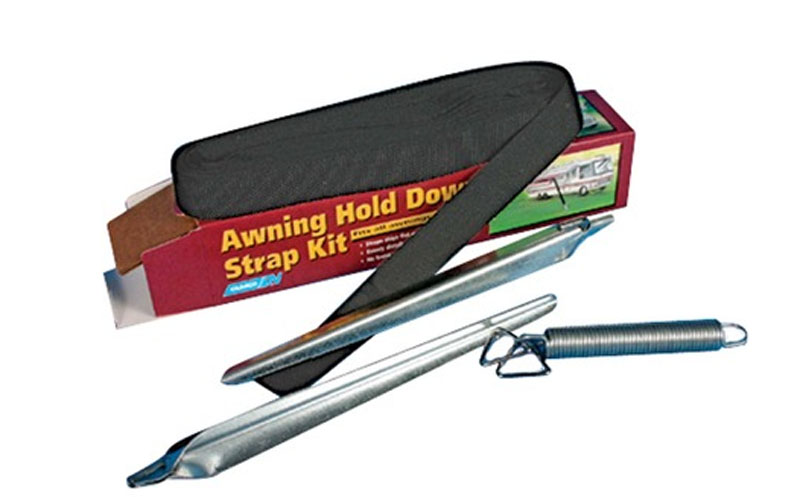On our first camping trip in the brand 2006 Niagara, Joyce’s only negative comment was, “Get another awning, whatever it costs.”
The awning that came with our new camper was just like the original that came with our 1992 Starcraft Meteorite, only the Niagara’s was 14 feet long versus 8 feet for the Starcraft. The extra length made it even more difficult and irritating.
We solved the Meteorite conundrum by installing a Fiamma awning. Unfortunately a Fiamma awning to fit our 14 foot long roof would be too heavy. The maximum weight capacity of the in the down position is 300 pounds, and 150 pounds with the roof raised. With the roof-top air conditioner, solar system, and existing awning we were right at the maximum load. We need to find an awning that weighed about the same as what we had, which probably would mean another bag awning, not an aluminum encased model like the Fiamma.
I finally located a suitable awning from a company named Shademaker. The design was much better than the original, not a good as a Fiamma. The good news is that we paid under $200 and a Fiamma would have been over $2,000 (2006 prices).
Shademaker has two models, the Classic and the Supreme. I do not want the Classic because it had round poles and twist lock legs; not much better than what we had. The Supreme uses stronger square aluminum tubes for the rafters and legs, and both fold into the header bar for easier set-up and take-down.
We have had this awning for 7 years and it was held up and worked well. Also the first awning we bought from Shademaker was defective (something I noticed before installation) and I had a replacement shipped and delivered in two days. Good product and great service.
The Shademaker is a bag awning, which means it is stored in a 14 foot long vinyl bag that is attached to the side of the roof. This means there are two zippers that are pulled open to access the awning, and unlike the Fiamma awning with is aluminum housing case, can fall out of the bag. Generally it takes two people to set up a 14 foot bag awning. The Shademaker is pretty easy to set up, and I can do it by myself — I have had lots of experience setting it up solo. Often I go to the campground a day or two before Joyce, so I have no choice unless I bring a big folding ladder. When we set-up the camper together, Joyce always helps.
The steps we use to set up the awning:
- Raise the camper roof about 12 inches.
- Unzip the bag and pull out the rolled up awning.
- Walk away from the camper unrolling it as we move, keeping they material fairly taunt and somewhat parallel to the ground.
- Unfold the rafter and leg poles out of the front edge header on one side of the awning.
- Simultaneously place the front leg and rafter into position (can be carport mode or mounted to the side of the camper).
- Go to the other side and repeat the procedure.
- Lift the roof (sometimes it is necessary to stop and adjust the legs, especially when not in carport mode).
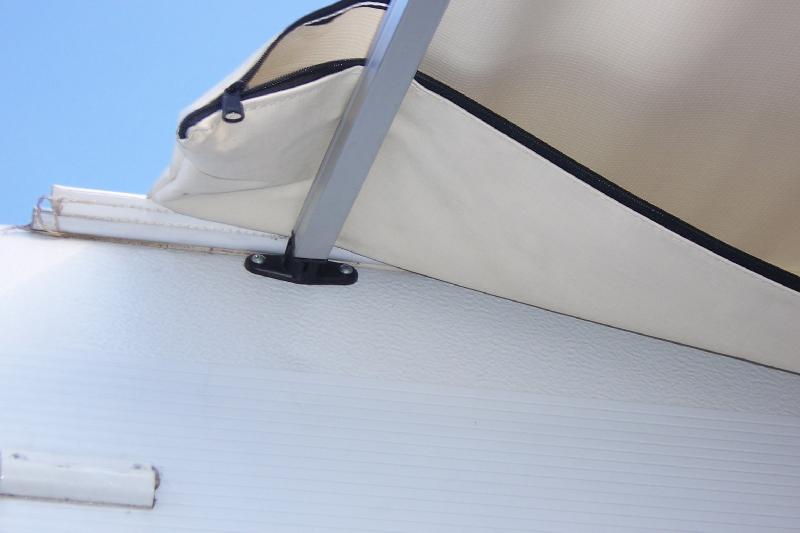 Above: Rafter snaps into plastic holders that need to be installed. The bag that holds the awning can be seen above the rafter.
Above: Rafter snaps into plastic holders that need to be installed. The bag that holds the awning can be seen above the rafter.
 Above: Push button provides tension on the rafter to hold it securely. Final adjustment will be shown later.
Above: Push button provides tension on the rafter to hold it securely. Final adjustment will be shown later.
 Above: Velcro secures edge of the awning material to the rafter.
Above: Velcro secures edge of the awning material to the rafter.
 Above: This clamping mechanism provides the final taunt adjustment.
Above: This clamping mechanism provides the final taunt adjustment.
 Above: Adjustment clamp closed.
Above: Adjustment clamp closed.
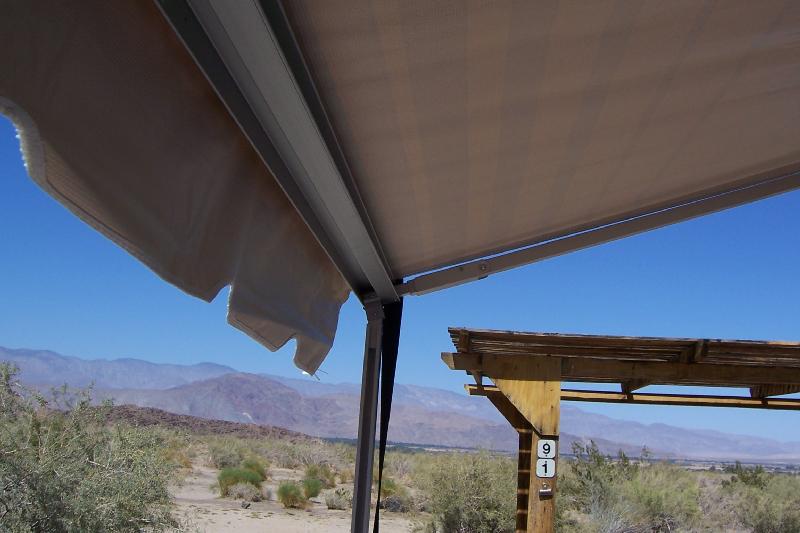 Above: The rafter and pole are connected to the header and swing into the grove shown in the header.
Above: The rafter and pole are connected to the header and swing into the grove shown in the header.
 Above: The pole or leg is moved up or down to adjust the height of the awning with this clamping mechanism.
Above: The pole or leg is moved up or down to adjust the height of the awning with this clamping mechanism.
 Above: Pole staked to the ground.
Above: Pole staked to the ground.
Awning pole upgrade
I purchased a pair of optional brackets from Shademaker so the awning poles could be attached to the side of the camper. The advantage to this, instead of carport mode is quicker set-up and much more secure in windy conditions. The one disadvantage is that at each end of the camper, the leg partially blocks the walking area; for us it is not a problem at all.
 Above: Bracket mounted to the trailer frame. This way the awning poles (legs) do not have to be set up like a carport, but can be attached to the camper.
Above: Bracket mounted to the trailer frame. This way the awning poles (legs) do not have to be set up like a carport, but can be attached to the camper.
I originally mounted the brackets to the side of the camper body just like we did on our old camper. Because the Shademaker awning has about double the surface area than the smaller Fiamma awning on our old tent trailer, there were a couple of potential problems in wind depending on direction and whether the wind was creating lift or exerting downward pressure.
 Above: Clamp that adjusts the pole.
Above: Clamp that adjusts the pole.
The first was that this larger awning created more force or pressure on the camper attachments points. So I was not comfortable with the mount on the side of the camper body. The second issue was that in strong winds the leg clamps could slowly slip over a period of time. Enough that open ending the camper door could cause the sharp top corner of the door to hit the awning material and tear it. Luckily we did not have any damage from wind before I completed the upgrades.
I decided to mount the leg brackets to the camper frame, which would much more secure, but I would need to somehow make the legs longer. The original configuration was two square channels of aluminum material, one inside the other. The inner channel slide in outer channel for adjustment and a clamp is used to lock it. However in high winds the clamp can slowly slip over a few hours, and the awning would be low enough to catch on the door.
 Above: Adjustment clamp opened for adjusting.
Above: Adjustment clamp opened for adjusting.
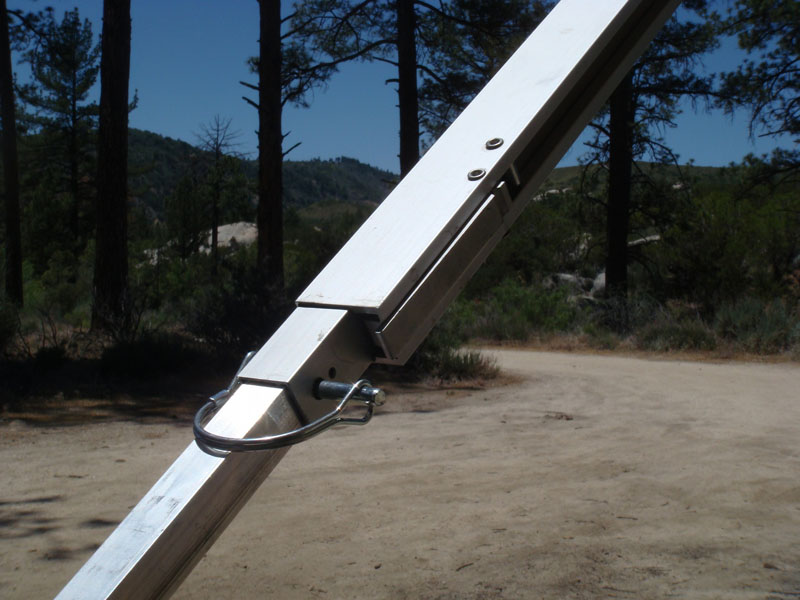 Above: Adjustment clamp closed.
Above: Adjustment clamp closed.
I found aluminum channel material at our local home improvement store that fit perfectly inside the smaller existing channel, which turned the pole into a three-section pole instead of two.
 Above: Pole now has 3 sections. Clevis pin can be adjusted to several positions in addition to the clamp.
Above: Pole now has 3 sections. Clevis pin can be adjusted to several positions in addition to the clamp.
I measured this 3rd section so that it could the entire pole could no longer drop low enough where the door could hit the awning.
Dealing with wind
Wind is an awning’s worst enemy (along with an awning that is not pitched correctly to drain water in the rain). For the past 20 years I have been using the Camco Awning Hold Down Strap Kit below.
 Above: The strap runs over the top of the awning and is anchored to the ground on each side. It can also be used when the poles are attached to the frame of the camper.
Above: The strap runs over the top of the awning and is anchored to the ground on each side. It can also be used when the poles are attached to the frame of the camper.
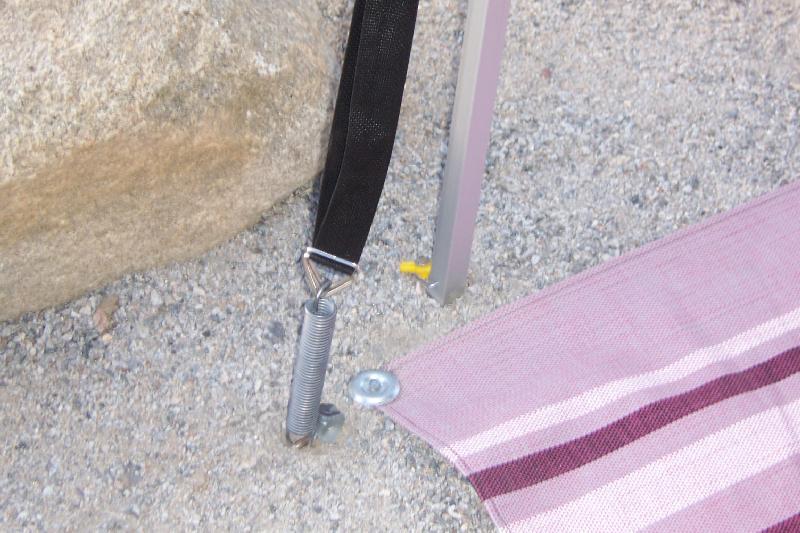 Above: Large stakes hold each end of the strap secure. One side has a spring to allow the awning to move some in strong winds.
Above: Large stakes hold each end of the strap secure. One side has a spring to allow the awning to move some in strong winds.

